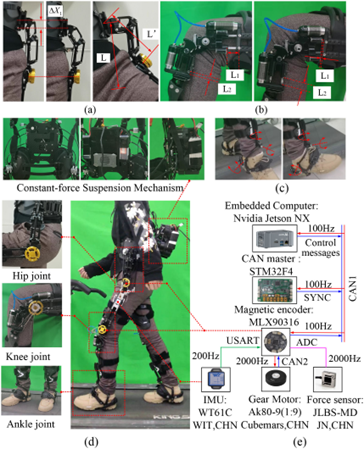The weight and inertial force of mechanical exoskeletons cause rapid changes in the impact force of the exoskeleton on the wearer. This force is often unavoidable when the exoskeleton is tightly worn around the operator’s body. Not only do these problems reduce the comfort and portability of the exoskeleton, but they also increase the operator’s energy consumption.
The State Key Laboratory of Robotics and Systems at the Harbin Institute of Technology has proposed a new type of mechanical exoskeleton incorporating a c constant-force suspension mechanism and self-adapting compliant joints

Mechanical exoskeleton incorporating a constant-force suspension mechanism worn on the lower limbs of the human body
The constant-force suspension mechanism is designed to reduce the impact of the exoskeleton’s weight on the wearer. At speeds of 5 and 9 km/hr, the experimenter wearing the exoskeleton with the constant-force suspension mechanism achieved a net metabolic reduction of 10.95/4.40% and 1.71/4.54% respectively, compared to the test exoskeleton without the constant-force suspension mechanism. These results indicate that such a system may effectively assist the exoskeleton operator’s movement.
self-adapting compliant joints were also designed to reduce the misalignment between the joints of the exoskeleton and the operator. The researchers designed an exoskeletal knee joint that allowed the exoskeleton to synchronize with the human body, creating an accurate instantaneous rotation center (ICR) between the exoskeleton and the body. Exoskeletal hip joints were also designed to distinguish between standing and other postures, then use this data to form an ICR.
To evaluate the effectiveness of self-adapting compliant joints, the HIT researchers used NOKOV motion capture technology for precise measurement. Eight NOKOV MARS cameras recorded the motion data of experimental subjects both wearing and not wearing exoskeletons. The resulting data showed that the misalignment between the mechanical exoskeleton with adaptive softening joints and the operator’s body were extremely small and that the effects of the exoskeleton on the operator’s gait were negligible.
References: H. Li, D. Sui, H. Ju, Y. An, J. Zhao and Y. Zhu, Mechanical Compliance and Dynamic Load Isolation Design of Lower Limb Exoskeleton for Locomotion Assistance, in IEEE/ASME Transactions on Mechatronics, 2022, doi: 10.1109/TMECH.2022.3181261.
Bibliography: